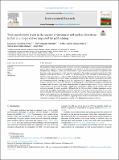Por favor, use este identificador para citar o enlazar a este item:
http://hdl.handle.net/10261/296787COMPARTIR / EXPORTAR:
 SHARE SHARE
 CORE
BASE CORE
BASE
|
|
| Visualizar otros formatos: MARC | Dublin Core | RDF | ORE | MODS | METS | DIDL | DATACITE | |

| Título: | Toxic metal(loids) levels in the aquatic environment and nuclear alterations in fish in a tropical river impacted by gold mining |
Autor: | Córdoba-Tovar, Leonomir; Marrugo-Negrete, José; Ramos Barón, Pablo Andrés; Calao-Ramos, Clelia Rosa; Díez, Sergi CSIC ORCID | Palabras clave: | Sediment Atrato river Fish Mercury Micronucleus |
Fecha de publicación: | 17-feb-2023 | Editor: | Elsevier | Citación: | Environmental Research 224: 115517 (2023) | Resumen: | The Atrato River basin was protected by Colombian law due to anthropogenic impacts, mainly from illegal gold mining, which triggered a critical environmental health problem. In this study we quantified mercury (Hg), methylmercury (MeHg) and arsenic (As) concentrations in aquatic environmental matrices, and explored for the first-time nuclear degenerations in fish from the Atrato River. The median concentrations (μg/kg) for T-Hg, MeHg and As in fish were 195.0, 175.5, and 30.0; in sediments (μg/kg) 165.5, 13.8 and 3.1; and in water (ng/L), 154.7 for T-Hg and 2.1 for As. A 38% and 10% of the fish exceeded the WHO limit for the protection of populations at risk (200 μg Hg/kg) and for human consumption (500 μg Hg/kg); while As concentrations were below the international standard (1000 μg/kg) in all fish. The percentage of MeHg was 89.7% and the highest accumulation was observed in carnivorous fish (336.3 ± 245.6 μg/kg, p < 0.05) of high consumption, indicating risk to human health. In water, T-Hg concentrations exceeded the threshold effect value of 12 ng/L, whereas As concentrations were below the threshold of 10,000 ng/L, established by USEPA. On the contrary, 33% of the sediments exceeded the quality standard of 200 μg/kg for Hg. We found that Prochilodus magdalenae was the species with the highest susceptibility to nuclear alterations in its order, nuclear bud (CNB, 3.7 ± 5.4%), micronuclei (MN, 1.6 ± 2.5%) and binucleated cells (BC, 1.6 ± 2.3%). These results indicate that the species appears to be a good predictor of genotoxicity in the Atrato River. Fulton's condition factor (K) indicated that 31.7% of the fishes had poor growth condition, suggesting that the Atrato River basin needs to be monitored and restored in accordance with the agreements reached in the Minamata Convention on Mercury. | Versión del editor: | https://doi.org/10.1016/j.envres.2023.115517 | URI: | http://hdl.handle.net/10261/296787 | DOI: | 10.1016/j.envres.2023.115517 | ISSN: | 00139351 |
| Aparece en las colecciones: | (IDAEA) Artículos |
Ficheros en este ítem:
| Fichero | Descripción | Tamaño | Formato | |
|---|---|---|---|---|
| 1-s2.0-S0013935123003092-main.pdf | Artículo principal | 3,48 MB | Adobe PDF |  Visualizar/Abrir |
| 1-s2.0-S0013935123003092-mmc1.docx | Material suplementario | 1,13 MB | Microsoft Word XML | Visualizar/Abrir |
CORE Recommender
PubMed Central
Citations
1
checked on 17-abr-2024
SCOPUSTM
Citations
4
checked on 28-abr-2024
WEB OF SCIENCETM
Citations
4
checked on 26-feb-2024
Page view(s)
26
checked on 03-may-2024
Download(s)
97
checked on 03-may-2024
Google ScholarTM
Check
Altmetric
Altmetric
Artículos relacionados:
NOTA: Los ítems de Digital.CSIC están protegidos por copyright, con todos los derechos reservados, a menos que se indique lo contrario.
